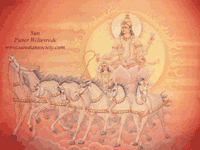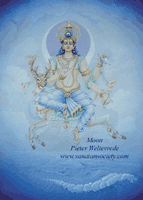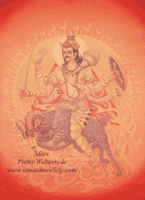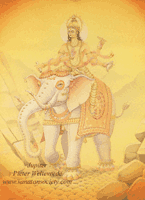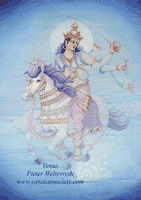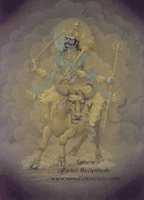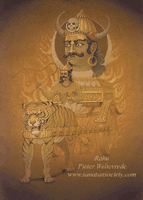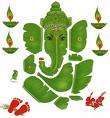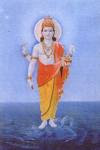HOW PLANETS AFFECT US
Vedic Astrology is based on the ancient Indian theory of Karma and Rebirth, which says that actions (Karma) performed by all living beings are minutely recorded and are instrumental in deciding their fate in this life and next.
Vedic Philosophy says that all Souls go through a constant cycle of life and death.
When a person dies, it is only his visible, external, gross physical body that dies.
The inner, invisible body, which lives inside the visible outer body, does not die. It simply sets loose from the dead outer body, and floats away upwards, beyond the earth's atmosphere, into the space that exists between our earth and the moon. This space is called the Antariksha.
A detailed description of the 'Inner Self' is found in Ayurveda, the Indian System of Medicine. Suffice here to say that this Self essentially consists of a person's 'five Dynanindriyas + five Karmendriyas + Mind Quartet + five Pranas + the Atma or Soul'.
This Inner Self contains a person's Chitta, which is part of his Mind quartet.
Unbeknownst to him, the person's Karma in his life just concluded, along with his accumulated karma in all his past lives, is imprinted on his Chitta.
Chitta carries his karma record forward from one life to the next one. He is, however, never conscious of it.
Karma gets automatically and continuously recorded on the Chitta in the form of a 'Planetary language'.
Platetary language is the 'software' of Karma, while Chitta is the 'hardware'!
Planetary 'language' works through visible and invisible Energies, including through rays of light energy.
Each colour of our visible spectrum has been assigned to a particular planet (Sun: orange, Moon: blue, Mars: red, Mercury: green, Jupiter: yellow, Venus: violet, Saturn: indigo).
Rays of different colours act on us, causing planetary effects.
This is how planetary language is translated into action.
The two 'shadow planets', Rahu and Ketu, are invisible entities; they perhaps send rays towards us that are outside of our visible spectrum and hence invisible to us. Or, they could be sending magnetic energy, or some other energy which is yet to be identified and defined.
The seven visible planets may be sending energies other than light energy, as well.
We don't know much about that, as yet. But it is certainly a very strong possibility.
The planets and their energies form the matrix of Karma, upon which life and rebirth take place, with the passage of time.
There is a very powerful mantra in Sanskrit language, called 'Nava graha stotra', recitation of which is said to offer complete protection to a person, in all spheres of life.
Let us now see how we can co-relate Vedic Astrology with modern-day Neuro-physiology.
The CHAKRAS and NADIS.
How does a planetary language work on our body?
It works through a system of chakras and nadis that form a part of what may be called the "Autonomous Nervous System of Ayurveda".
This System is briefly described as follows:
Ayurveda says that three strands of Cosmic energy enter our body through the Umbilical region. Upon entering, they divide and subdivide into a total of seventy-two thousand energy strands, which are called nadis.
The nadis enmesh, run through and connect our visible and invisible body, bind them together and also become the lines of communication between them.
Chakras are localised, invisible, rotating discs of energy, situated at various levels along the spine.
Seven main chakras are described.
From below upwards, they are:
Chakra name Situated Function Ruling Planet
Mooladhar perineum Survival Mars
Swadhishthan Coccyx Procreation Venus
Manipur Umbilicus Wealth, fame Sun
Anahat Heart Faith, Mercury
Vishuddha Throat Wisdom Jupiter
Agnya Brow non-duality Saturn
Sahasrar Crown Mukti nil
There is another important chakra, called the Chandramandal, near the Pineal gland. It controls the secretion of various 'dravyas' that look after Metabolism. In other words, I would say, it controls the secretion of hormones, which in turn, regulate enzymes and through them, the cellular funtion of the body.
The Chandramandal is regulated by the Moon.
Three main nadis, starting in the mooladhar chakra, run upwards through the various chakras, carrying vital forces of life energy.
At the base of the central or Sushumna nadi, lies Kundalini shakti, coiled up and in a dormant state.
Yogic awakening of this shakti by making it rise upwards through the chakras leads to Self-realisation and Enlightenment, freeing us from the bondage of Karma and from the eternal cycle of life and death.
To the left of the central nadi, runs the Ida nadi, which carries breath (Prana) from our left nostril. This nadi is governed by the Moon.
To the right of the central nadi, runs the Pingala nadi, which carries breath (Prana) from our right nostril. This nadi is governed by the Sun.
Several other nadis performing many important functions have been described as well in Ayurvedic textbooks.
Speaking in modern language, I would say that afferent and efferent nadis carry information to and from the chakras.
Chakras are places where information is processed and stored for communication with the end organs of the body.
A detailed description of the chakras and nadis is available in books on Yoga and in many articles on the internet as well. They make for fascinating reading and should be read by all serious students of this subject.
My impression of:
The AUTONOMOUS SYSTEM of YOGA.
The information which the chakras process relates to all the three planes of our body viz. physical, emotional and mental,
Our Chandramandal is functionally linked to our conscious and sub-conscious mind, through the Moon.
We might say Chandramandal is the body's inner Moon and is a reflection of the celestial Moon itself.
I would like to postulate that Chandramandal structurally encompasses the Hypothalamus and in this way it regulates the Pituitary - Hypothalamic axis and controls the entire Neuro-endocrinal System.
Afferent and efferent nadis form the afferent and efferent pathways of the Neuro-endocrinal System of modern medicine, with Chandramandal being the control room.
The Moon has 16 phases (kalas). The kalas 'increase' during the bright half of a month and 'decrease' during the dark half.
Each kala is ruled by a channel of energy called Nitya devi. There are, thus, 16 Nitya devis.
(Devi = Shakti = Energy. Hence, Devis are nothing but personified energies).
During the bright half of a month, the moon receives specific energies from the Sun through Nitya devis.
The moon thus gains energy and increases by one kala on each tithi (day) during the bright half.
Immediately after the full moon, Nitya devis begin to transfer this energy from the Moon to our earth. So, the Moon loses one kala every tithi, till it is emptied of all the energy it had received from the Sun, by the new moon (amavasya) day.
In this way it becomes easy to understand how cosmic and planetary energies affect and govern us through our lives.
YOGA and the CHAKRAS:
Patanjali's Yogasutra describes several paths in the journey towards Mukti, namely, Bhakti yoga, Dynana yoga and Karma yoga.
(Hatha yoga is a different entity altogether. It deals with physical postures called asanas and should not be confused with the other Yogas).
BHAKTI Yoga is the essence of all established religions and is the essence of any form of worship.
Here, there is a worshipper and there is an 'object' of his worship. The two are separate entities, physically and conceptually.
Anahat chakra is the seat of Bhakti. All activities related to bhakti occur in this chakra.
When Mind engages in devotional activity, there occurs a secretion and release of some Endorphin-type of hormone, which makes the person feel good / satisfied / fulfilled etc as per his religious upbringing, thinking, and status.
All this occurs through pathways of afferent and efferent nadis connected mainly with Anahat chakra.
I would like to point out that this chakra is stimulated by devotion, compassion and other such emotions.
It does not depend upon what or who the devotion is directed towards, it is the strength and sincerity of the emotion of the devotion itself which matters.
So, it wouldn't matter if the emotion were to address an invisible God of a monotheist religion or an idol of polytheist Hinduism, or the raw forces of Nature, or any other form of divine worship,
The hormonal output and the end result in each case would be the same.
The emotions generated by the release of 'Bhakti' hormones would be the same.
The worshipper's faith in his belief system would also be fortified every time the hormone is released.
If his particular belief system strictly disallows divergence from its own dogma, he would be able to convince himself that only his belief system is the correct one and that all other belief systems and forms of worship are wrong.
The outcome of restrictive religious dogma is religious wars, which have occurred since time immemorial,
DYANA Yoga:
Dyana means Knowledge.
Vishuddha chakra, which is above Anahat chakra, is where knowledge is distilled, spiritually speaking.
A person who seeks self inquiry rather than mere worship, 'travels' to this chakra and begins to 'live in it'. He reads Scriptures and Literature and rather than accept and follow them verbatim, looks beyond the dogma they may contain and tries to rationalise.
This is what I am doing, right now, of course.
He becomes dissociated from the attractions of Swadhishthan and Manipur chakras, which are concerned with 'bhukti' (fulfillment of earthly desires) and seeks liberation (mukti) from the cycle of life, death and rebirth.
Through meditation and other such efforts prescribed by the Shastras (doctrinal Literature), he begins to progressively live in an introspective world.
A person living in Vishuddha chakra may retain his devotional instincts but he will not be confined by them.
KARMA Yoga (Agnya chakra)
This is a bit of a misnomer because it doesn't relate to doing good or pure karma, as such, but rather, to going beyond karma altogether.
A well intentioned person who does good karma all the time (or most of the time) would be far more likely to be living in his Anahat chakra, which is also the seat of compassion.
Agnya chakra is where all sense of duality is lost and a person attains Enlightenment. This is not within the reach of ordinary mortals. It needs something far more than human endeavour. Grace, perhaps. I wouldn't know. But great Yogis have attained that state and their experiences are documented in Indian Literature.
Some of these Yogis are said to have transcended Space and Time. This happens in the Sahasrar or Crown chakra.
***************************************************
Vedic Astrology is based on the ancient Indian theory of Karma and Rebirth, which says that actions (Karma) performed by all living beings are minutely recorded and are instrumental in deciding their fate in this life and next.
Vedic Philosophy says that all Souls go through a constant cycle of life and death.
When a person dies, it is only his visible, external, gross physical body that dies.
The inner, invisible body, which lives inside the visible outer body, does not die. It simply sets loose from the dead outer body, and floats away upwards, beyond the earth's atmosphere, into the space that exists between our earth and the moon. This space is called the Antariksha.
A detailed description of the 'Inner Self' is found in Ayurveda, the Indian System of Medicine. Suffice here to say that this Self essentially consists of a person's 'five Dynanindriyas + five Karmendriyas + Mind Quartet + five Pranas + the Atma or Soul'.
This Inner Self contains a person's Chitta, which is part of his Mind quartet.
Unbeknownst to him, the person's Karma in his life just concluded, along with his accumulated karma in all his past lives, is imprinted on his Chitta.
Chitta carries his karma record forward from one life to the next one. He is, however, never conscious of it.
Karma gets automatically and continuously recorded on the Chitta in the form of a 'Planetary language'.
Platetary language is the 'software' of Karma, while Chitta is the 'hardware'!
Planetary 'language' works through visible and invisible Energies, including through rays of light energy.
Each colour of our visible spectrum has been assigned to a particular planet (Sun: orange, Moon: blue, Mars: red, Mercury: green, Jupiter: yellow, Venus: violet, Saturn: indigo).
Rays of different colours act on us, causing planetary effects.
This is how planetary language is translated into action.
The two 'shadow planets', Rahu and Ketu, are invisible entities; they perhaps send rays towards us that are outside of our visible spectrum and hence invisible to us. Or, they could be sending magnetic energy, or some other energy which is yet to be identified and defined.
The seven visible planets may be sending energies other than light energy, as well.
We don't know much about that, as yet. But it is certainly a very strong possibility.
The planets and their energies form the matrix of Karma, upon which life and rebirth take place, with the passage of time.
There is a very powerful mantra in Sanskrit language, called 'Nava graha stotra', recitation of which is said to offer complete protection to a person, in all spheres of life.
Let us now see how we can co-relate Vedic Astrology with modern-day Neuro-physiology.
The CHAKRAS and NADIS.
How does a planetary language work on our body?
It works through a system of chakras and nadis that form a part of what may be called the "Autonomous Nervous System of Ayurveda".
This System is briefly described as follows:
Ayurveda says that three strands of Cosmic energy enter our body through the Umbilical region. Upon entering, they divide and subdivide into a total of seventy-two thousand energy strands, which are called nadis.
The nadis enmesh, run through and connect our visible and invisible body, bind them together and also become the lines of communication between them.
Chakras are localised, invisible, rotating discs of energy, situated at various levels along the spine.
Seven main chakras are described.
From below upwards, they are:
Chakra name Situated Function Ruling Planet
Mooladhar perineum Survival Mars
Swadhishthan Coccyx Procreation Venus
Manipur Umbilicus Wealth, fame Sun
Anahat Heart Faith, Mercury
Vishuddha Throat Wisdom Jupiter
Agnya Brow non-duality Saturn
Sahasrar Crown Mukti nil
There is another important chakra, called the Chandramandal, near the Pineal gland. It controls the secretion of various 'dravyas' that look after Metabolism. In other words, I would say, it controls the secretion of hormones, which in turn, regulate enzymes and through them, the cellular funtion of the body.
The Chandramandal is regulated by the Moon.
Three main nadis, starting in the mooladhar chakra, run upwards through the various chakras, carrying vital forces of life energy.
At the base of the central or Sushumna nadi, lies Kundalini shakti, coiled up and in a dormant state.
Yogic awakening of this shakti by making it rise upwards through the chakras leads to Self-realisation and Enlightenment, freeing us from the bondage of Karma and from the eternal cycle of life and death.
To the left of the central nadi, runs the Ida nadi, which carries breath (Prana) from our left nostril. This nadi is governed by the Moon.
To the right of the central nadi, runs the Pingala nadi, which carries breath (Prana) from our right nostril. This nadi is governed by the Sun.
Several other nadis performing many important functions have been described as well in Ayurvedic textbooks.
Speaking in modern language, I would say that afferent and efferent nadis carry information to and from the chakras.
Chakras are places where information is processed and stored for communication with the end organs of the body.
A detailed description of the chakras and nadis is available in books on Yoga and in many articles on the internet as well. They make for fascinating reading and should be read by all serious students of this subject.
My impression of:
The AUTONOMOUS SYSTEM of YOGA.
The information which the chakras process relates to all the three planes of our body viz. physical, emotional and mental,
Our Chandramandal is functionally linked to our conscious and sub-conscious mind, through the Moon.
We might say Chandramandal is the body's inner Moon and is a reflection of the celestial Moon itself.
I would like to postulate that Chandramandal structurally encompasses the Hypothalamus and in this way it regulates the Pituitary - Hypothalamic axis and controls the entire Neuro-endocrinal System.
Afferent and efferent nadis form the afferent and efferent pathways of the Neuro-endocrinal System of modern medicine, with Chandramandal being the control room.
The Moon has 16 phases (kalas). The kalas 'increase' during the bright half of a month and 'decrease' during the dark half.
Each kala is ruled by a channel of energy called Nitya devi. There are, thus, 16 Nitya devis.
(Devi = Shakti = Energy. Hence, Devis are nothing but personified energies).
During the bright half of a month, the moon receives specific energies from the Sun through Nitya devis.
The moon thus gains energy and increases by one kala on each tithi (day) during the bright half.
Immediately after the full moon, Nitya devis begin to transfer this energy from the Moon to our earth. So, the Moon loses one kala every tithi, till it is emptied of all the energy it had received from the Sun, by the new moon (amavasya) day.
In this way it becomes easy to understand how cosmic and planetary energies affect and govern us through our lives.
YOGA and the CHAKRAS:
Patanjali's Yogasutra describes several paths in the journey towards Mukti, namely, Bhakti yoga, Dynana yoga and Karma yoga.
(Hatha yoga is a different entity altogether. It deals with physical postures called asanas and should not be confused with the other Yogas).
BHAKTI Yoga is the essence of all established religions and is the essence of any form of worship.
Here, there is a worshipper and there is an 'object' of his worship. The two are separate entities, physically and conceptually.
Anahat chakra is the seat of Bhakti. All activities related to bhakti occur in this chakra.
When Mind engages in devotional activity, there occurs a secretion and release of some Endorphin-type of hormone, which makes the person feel good / satisfied / fulfilled etc as per his religious upbringing, thinking, and status.
All this occurs through pathways of afferent and efferent nadis connected mainly with Anahat chakra.
I would like to point out that this chakra is stimulated by devotion, compassion and other such emotions.
It does not depend upon what or who the devotion is directed towards, it is the strength and sincerity of the emotion of the devotion itself which matters.
So, it wouldn't matter if the emotion were to address an invisible God of a monotheist religion or an idol of polytheist Hinduism, or the raw forces of Nature, or any other form of divine worship,
The hormonal output and the end result in each case would be the same.
The emotions generated by the release of 'Bhakti' hormones would be the same.
The worshipper's faith in his belief system would also be fortified every time the hormone is released.
If his particular belief system strictly disallows divergence from its own dogma, he would be able to convince himself that only his belief system is the correct one and that all other belief systems and forms of worship are wrong.
The outcome of restrictive religious dogma is religious wars, which have occurred since time immemorial,
DYANA Yoga:
Dyana means Knowledge.
Vishuddha chakra, which is above Anahat chakra, is where knowledge is distilled, spiritually speaking.
A person who seeks self inquiry rather than mere worship, 'travels' to this chakra and begins to 'live in it'. He reads Scriptures and Literature and rather than accept and follow them verbatim, looks beyond the dogma they may contain and tries to rationalise.
This is what I am doing, right now, of course.
He becomes dissociated from the attractions of Swadhishthan and Manipur chakras, which are concerned with 'bhukti' (fulfillment of earthly desires) and seeks liberation (mukti) from the cycle of life, death and rebirth.
Through meditation and other such efforts prescribed by the Shastras (doctrinal Literature), he begins to progressively live in an introspective world.
A person living in Vishuddha chakra may retain his devotional instincts but he will not be confined by them.
KARMA Yoga (Agnya chakra)
This is a bit of a misnomer because it doesn't relate to doing good or pure karma, as such, but rather, to going beyond karma altogether.
A well intentioned person who does good karma all the time (or most of the time) would be far more likely to be living in his Anahat chakra, which is also the seat of compassion.
Agnya chakra is where all sense of duality is lost and a person attains Enlightenment. This is not within the reach of ordinary mortals. It needs something far more than human endeavour. Grace, perhaps. I wouldn't know. But great Yogis have attained that state and their experiences are documented in Indian Literature.
Some of these Yogis are said to have transcended Space and Time. This happens in the Sahasrar or Crown chakra.
***************************************************











